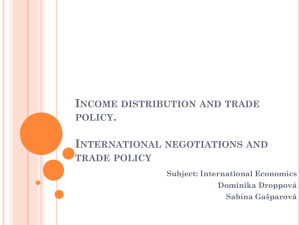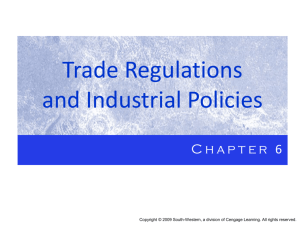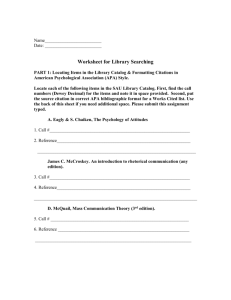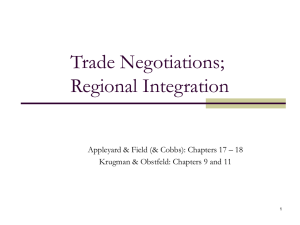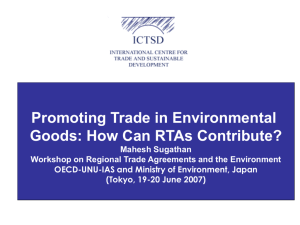Stalemate at the Negotiations on Environmental Goods and
advertisement
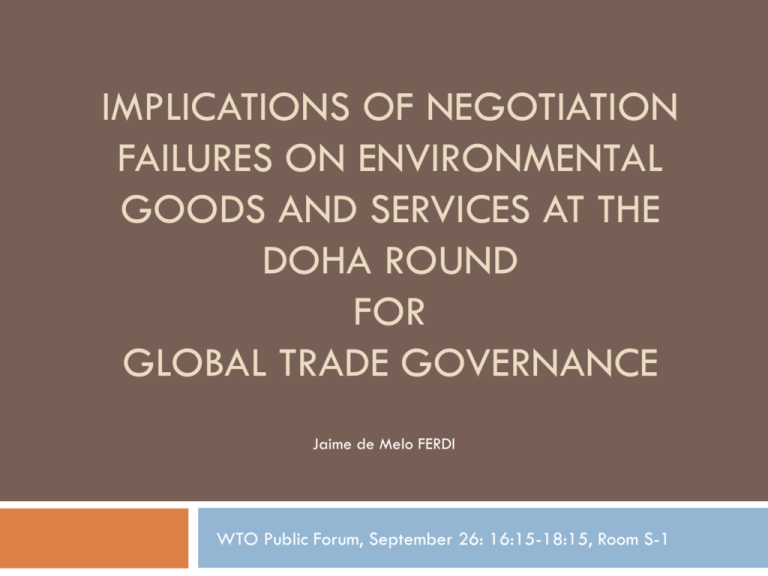
IMPLICATIONS OF NEGOTIATION FAILURES ON ENVIRONMENTAL GOODS AND SERVICES AT THE DOHA ROUND FOR GLOBAL TRADE GOVERNANCE Jaime de Melo FERDI WTO Public Forum, September 26: 16:15-18:15, Room S-1 Outline (based on paper available at http://www.ferdi.fr/uploads/sfCmsContent/html/112/P28.pdf ) 2 Doha art. 31: Countries mandated to negotiate on removing barriers to trade in EGS Anatomy of negotiations Difficulties (Causes of no progress) Strategic behavior (bargaining chip when negotiations are multi-dimensional) Problems in Identifying Egs. Different perceptions and interests Implications for Global Trade Governance: Go either for Three approaches: Project; request and offer; list) WTO ‘combined list’ and ‘core list’ of 26 products (2010) No visible progress (in relative terms) as tariff Reductions in EGs no greater than for other goods across country groupings and regions since launch in 2000 regional approach breakdown negotiations: plurilateral rather than multilateral deals What future for global trade governance? Approaches to Negotiations 3 Main Approaches : (i) «Request and offer» (e.g. Brazil); worked under early GATT when tariffs high: Now won’t work because tariff levels are too low (iI)«Integrated project» to deal with multiple-end use (e.g. Argentina and India). To be submitted by national authorities. (i) «list» (only proposed by developed countries). By 2008 13 countries proposed lists 411 HS-6 codes with little overlap (90 duplicates;35 triplicates; 7 quadruplicates) Core list in 2010 (26 HS-6 products) (see next slides) Figure 2 - The WTO Core list: number of HS six-digit codes per HS Chapter 135 140 14 120 4 100 80 65 60 121 46 4 19 20 1 9 3 52 3 26 40 4 61 1 1 1 1 4 45 46 47 43 3 5 1 1 1 53 56 63 69 70 28 48 3 3 1 0 25 27 28 29 38 39 40 WTO combined list only 25= salt, sulphur, earths and stone, lime and cement 27= mineral fuels, mineral oils and products of their distillation 28= inorganic chemicals 29= organic chemicals 38= misclellaneous chemical products 39= plastics and articles thereof 40= rubber and articles thereof 45= cork and articles of cork 46= manufactures of straw or of other plaiting materials 47= pulp of wood, recovered paper 53= vegetables fibres other than silk, wool or cotton 56= wadding, special yarns 4 73 76 84 85 87 89 90 WTO combined list and Core list 63= made up textile articles other than apparel 69= ceramic product 70= glass and glassware 73= articles of iron or steel 76= aluminium and articles thereof 84= nuclear reactors, boilers, machinery and mechanical appliances 85= electrical machinery and equipment 87= Vehicles 89= Ships and boats 90= Optical,.., measuring, checkong and precision instruments 94= Furniture, lamps and lighting fittings 95= toys, games and sports requisites 94 1 95 Core list products (sample): Limited overlap in lists and in environmental classifications 5 Environmental category Countries who proposed that good N° HS CODE 2002 HS CODE DESCRIPTION MEMBERS CATEGORY(IES) 7 840510 Producer gas or water gas generators, with or without their purifiers; acetylene gas FRD, SAU, PHL, SGP generators and similar water process gas generators, with or without their purifiers APC, RE, WM/WT, ET, CCS 8 840681 Steam turbines and other vapour turbines for marine propulsion: Of an output exceeding FRD, SAU, PHL 40 MW RE 9 840999 Parts suitable for use solely or principally with the engines of heading 84.07 or 84.08 FRD, SAU, SGP other APC, ET, CCS 10 841011 Hydraulic turbines and water wheels of a power not exceeding 1,000 kW FRD, SAU, PHL RE, ET, CCS 11 841012 Hydraulic Turbines and Water Wheels, Power 1, 000-10, 000kw SAU ET, CCS 12 841090 Hydraulic turbines, water wheels, and regulators ; parts, including regulators FRD, SAU, PHL RE, ET, CCS 13 841181 Other gas turbines of a power not exceeding 5,000 kW FRD, SAU, PHL, QAT RE, ET, CCS, OTH 14 841182 Other gas turbines of a power exceeding 5,000 kW FRD, SAU, PHL, QAT RE, ET, CCS, OTH APC=Air Pollution Control, RE=Renewable Energy, ET=Environmental Energy, CCS=Carbon Capture and Storage, WM/WT=Water Management / Water Treatment, OTH=Other 5 No progress in reducing tariffs (in relative terms) (No difference in tariff reduction Patterns between ‘core list’ and total trade) 6 Figure 3 - Evolution of the average rate of protection, 1996-2010 Core list and total trade, by income group Total trade 20 Core list 15 12.66 12.28 11.83 11.60 10 10.72 12.58 12.03 10.44 9.18 8.32 6.75 5 16.26 15.61 14.94 9.18 8.998.55 6.76 5.64 4.63 4.00 4.42 3.81 3.18 0 No «mandate effect» as no acceleration in reduction of protection after 2001 relative to reduction in protection for other products Especially for low-income countries Next slide shows outcome under standstill %, MFN applied High income Upper middleLower middle income income 1996-2000 Low income High income 2001-2005 Source: Authors’ calculations, from TRAINS tariff data (see Annex IV) Upper middleLower middle income income 2006-2010 Low income Difficulties (I): What is an EG? (Classifying GEMs and EPPs) 7 Figure 1: Identifying and Classifying Goods Related to the Preservation and Management of the Environment 7 Goods for Environmental Management (GEM) (Pollution, Resources) Multiple end-uses (pipes for water treatment or for natural gas) Identification of use Take a Project Approach Finer/alternative HS-(10) classification problematic (lock-in characteristics of HS code) Environmentally Preferable Products (EPPs): Single use Production -- Aluminium (Prebake vs. Soderberg) -- Organic cotton vs conventional cotton; Use -- Solar stoves -- Solar furnaces -- Energy efficient consumer goods Disposal --- packaging (glass vs. plastic) --- Cotton fiber versus synthetic fiber Identification Relativism: How to deal with like products Attribute Disclosure (requires an efficient disclosure mechanism (e.g. certification and harmonization) Processes and Production Methods (PPMs) and the like products at WTO Developing countries: PPM-based EGs would be high-jacked by DCs (“social concerns”) Difficulties (II): Countries submitted goods for which they had a comparative advantage… 8 % of goods proposed under the 2008 CTESS program with RCA>1(in 2007) Among the goods submitted by New Zeland (ie the 164 goods of the Friends’ list), 60% are goods for which it had a RCA >1 in 2007 Notes: COMTRADE export data, mirror data used for Philippines and Saudi Arabia. 384 products only, countries: Saudi Arabia, Philippines, Japan, United States, Canada, Korea, Norway, Taiwan, European Communities, New Zealand, Switzerland (ie last submissions of Qatar and Singapore not included) Difficulties (II) …and avoided submitting goods with tariff peaks Goods not proposed had significantly higher protection 9 Country Nb of peaks (over Nb of peaks the 384 goods) proposed Nb of peaks Nb of goods retained on the proposed final list individually Average Average protection of protection of goods not goods proposed proposed Difference Column A B C D E F G=F-E Canada 16 1 9 86 2.04 2.52 0.48* EU27 20 0 1 92 2 3.32 1.32*** Japan 61 0 11 92 0.25 0.83 0.58*** Korea 0 59 6.17 6.02 -0.15 New Zealand 0 81 3.21 2.59 -0.62** Norway 0 0 . . Switzerland 0 11 0 0 ChineseTaipei 17 0 0 27 3.13 5.19 2.06*** USA 9 2 2 110 1.59 2.73 1.14*** Japan (Add) 61 0 51 0 0.67 0.67*** Saudi Arabia 0 262 4.84 4.47 -0.37*** Philippines 32 17 2.9 4.61 1.71 Nine Members Other lists 1 Notes: Tariff data for 2008. Tariff peaks defined as number of products (HS-6 codes) for which the average rate of protection is above three times the average rate of protection of the 384 EGs (e.g. Canada has 16 tariff peaks). Column B shows that of these 16 products, Canada only proposed 1 to figure on the 9M list. Column C shows that 9 of these 16 products were retained to figure on the final list. Colmns E and F show that, on average, the protection is higher for goods that Canada proposed (86 HS-6) than for those it did not. This difference is significant at 10% confidence level (column g). *** significant at 1% level, ** 5%, * 10% Source: authors’ calculations from TRAINS tariff data. Average protection is simple average of HS6 average tariffs. Implications for Global Trade Governance 10 Members did not act on article 31 mandate Strategic behavior was encouraged by multi-dimensionality of negotiations cum consensus Stakes not sufficiently high (5<tariff<10% range) for «request-andoffer »bargaining to be worthwhile—the locomotive of early GATT rounds Technical difficulties in defining EGs (GEMs and EPPs) Genuine differences in interests (better resolved by negotiations at regional level) Political-economy of submissions on lists (only those with low tariffs – around 3% were proposed) Implications Follow the regional route Drop multilateral negotiations for plurilateral negotiations (allowed under WTO, e.g. GPA, ITA) …what future for Global Trade Governance? 11 Growing tensions between environmentalists and trade communities .. By 2020 China’s contribution to global CO2 stock in atmosphere (since 1980) will exceed US’ A bilateral world trading system (US-China) with others joining the rules of the game set by them ? (à la 19th c. with France-GB in the 1860s) Tackle environmental problems on a regional basis (e.g. APEC has negotiated on 54 Egs) Take inspiration from Montreal protocol on CFCs or MARPOL (convention on prevention of pollution from ships) for sectoral treaties (e.g. on aluminium, fuel for ships) How will adjudication process of AB stand up when cases on energy subsidies will be brought to them? Need for a World Climate Organization?
